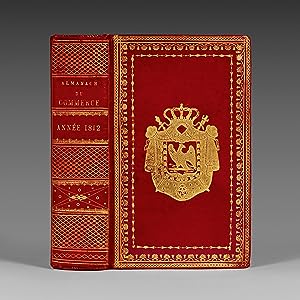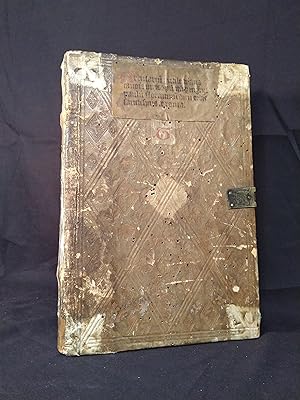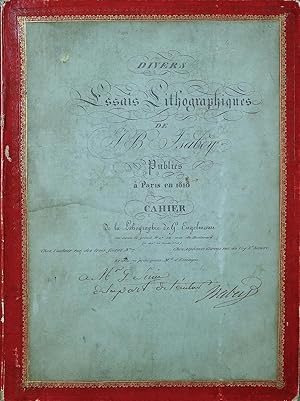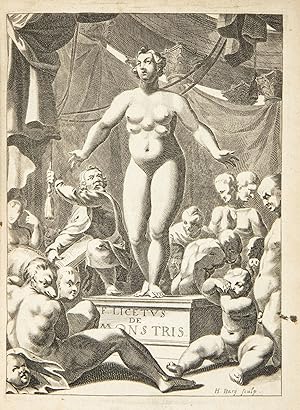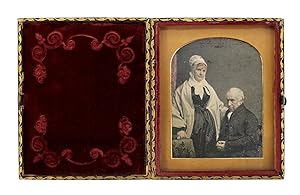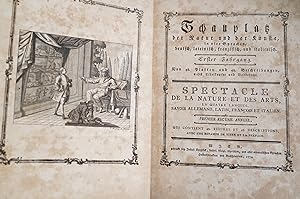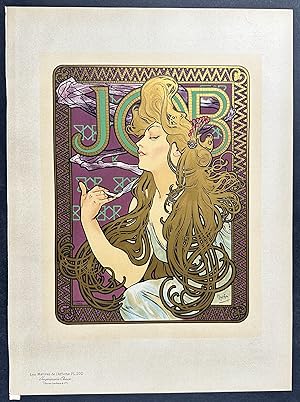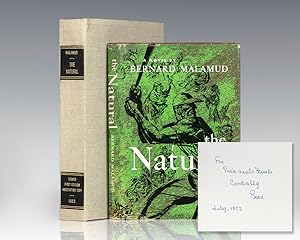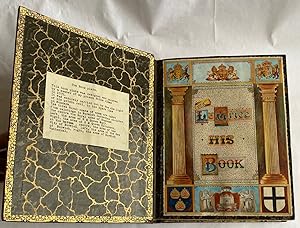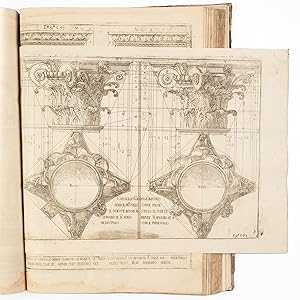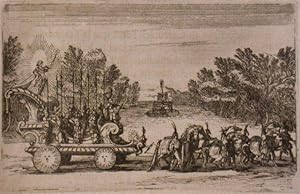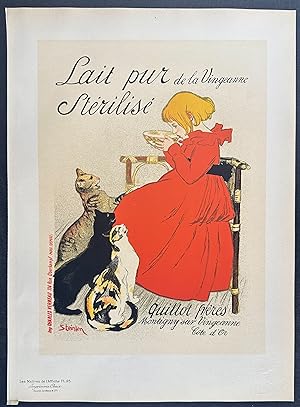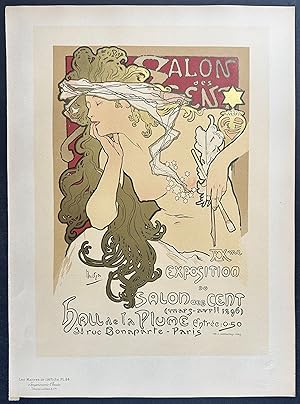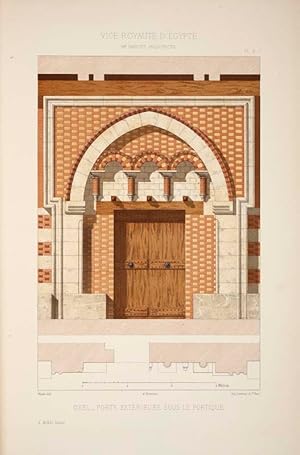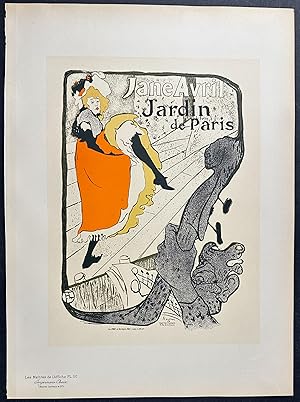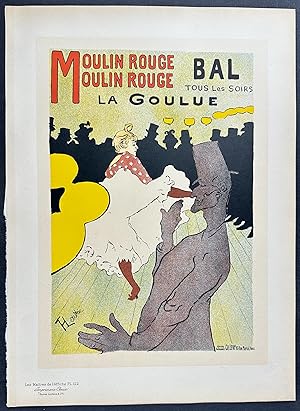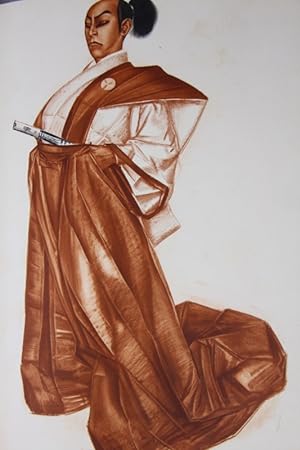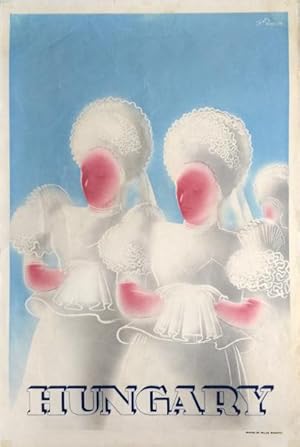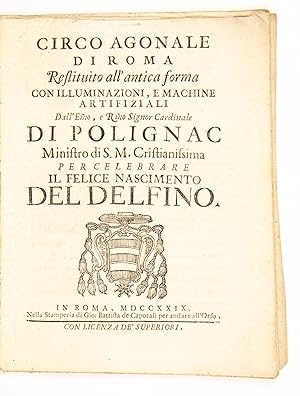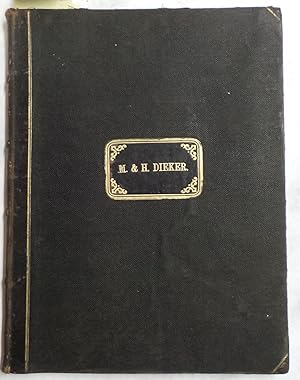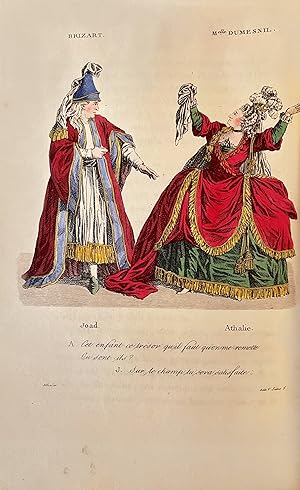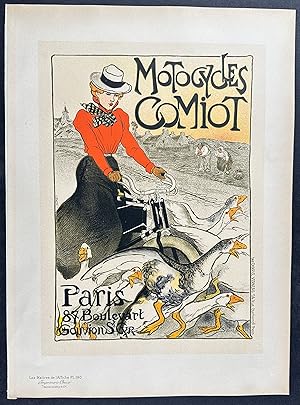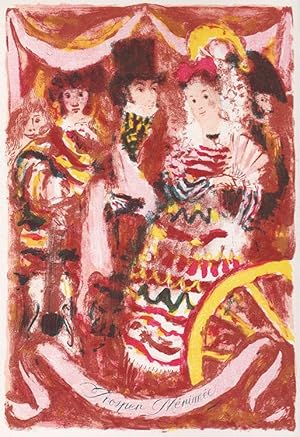art spectacle, Couverture rigide (Plus de 3 000 résultats)
Type d'article
- Tous les types d'articles
- Livres (2 816)
- Magazines & Périodiques
- Bandes dessinées (1)
- Partitions de musique (2)
- Art, Affiches et Gravures (182)
- Photographies (9)
- Cartes
-
Manuscrits &
Papiers anciens (2)
Etat
Reliure
- Toutes
- Couverture rigide
- Couverture souple
Particularités
- Edition originale (450)
- Signé (65)
- Jaquette (563)
- Avec images (2 065)
- Sans impression à la demande (2 831)
Livraison gratuite
Pays
Evaluation du vendeur
-
Victoria Regia; or the Great Water Lily of America. With a brief account of its discovery and introduction into cultivation: with illustrations by William Sharp, from specimens grown at Salem, Massachusetts, U.S.A.
Edité par printed and published for the author by Dutton & Wentworth, Boston, 1854
Vendeur : Donald A. Heald Rare Books (ABAA), New York, NY, Etats-Unis
Broadsheet. (27 x 21 inches). Letterpress title, 1p. dedication to Caleb Cope, 12pp. text (numbered [5]-16); 1p. index, plate list, note and errata. 6 chromolithographic plates by Sharp & Sons of Dorchester, Mass, 5 after William Sharp, 1 after Allen. Original publisher's brown paper lettered upper wrapper bound in. Expertly bound to style in half green morocco and marbled paper covered boards, spine gilt with raised bands A monument to American colour printing, a work which launched the age of chromolithography as an art in the United States. This work is one of very few truly great American botanical works and is one of the most beautiful flower books ever produced. The Victoria Regia; or the Great Water Lily of America, provides an appropriate showcase for this gigantic water lily, first discovered along the Amazon River and then taken to Britain for cultivation. The so-called "vegetable wonder" was first described by Sir R. H. Schomburg in 1837. From the details he gave, the botanist John Lindley suggested that the lily was a new genera and put forward the name Victoria Regia in honour of Queen Victoria during the first year of her reign. "The giant water-lily is a spectacular flower; nineteenth century commentators describe with amazement the vast dimensions of its floating leaves, which could exceed two meters in diameter, and its great white flower, which opened in the evening and closed again at dawn in a truly lovely spectacle" (Oak Spring Flora). In 1853, Allen, a well-respected horticulturalist and author of a treatise on viticulture, cultivated a seed from the water-lily given to him by Caleb Cope, president of the Pennsylvania Horticultural Society, and the man in whose garden the water-lily first flowered in America on 21 August 1851. Working at his home in Salem, Massachusetts, Allen tended the seed from January to July, when, on the evening of July 21st, the flower finally bloomed. Motivated by his success, Allen hoped to make the glory of the water-lily available to a wider audience and engaged the services of William Sharp, a British-born artist and pioneer of chromolithography then working in Boston. Sharp had been practicing with the new technique of chromolithography as early as 1841, the first person to do so in the United States. His early efforts can be seen in Mattson's The American Vegetable Practice (1841), but, as McGrath states, those chromolithographs are merely "passable." Fortunately, Sharp improved his technique, and his next major project, the plates for Hovey's The Fruits of America (1852), demonstrated to all who viewed them the colourful and dramatic potential of chromolithography. Still, the process was in its infancy, and it would take a work of tremendous ambition to satisfactorily popularise the technique. Allen's proposed book on the water-lily provided such a vehicle. Though the first plate of the Victoria Regia is based on a sketch Allen composed himself, the remaining five plates, which show the gradual development of the flowers from bud to full bloom, are wholly attributable to Sharp. Superlative in concept, colour, and execution, they became the first benchmark of the art. "In the large water lily plates of Victoria Regia, Sharp printed colors with a delicacy of execution and technical brilliance never before achieved in the United States" (Reese, Stamped with a National Character). Great Flower Books (1990) p.69; Hofer Bequest 72; Hunt Printmaking in the Service of Botany 56; Nissen BBI 16; Reese Stamped with a National Character 19; Stafleu & Cowan TL2 85; Tomasi An Oak Spring Flora 106.
-
Victoria Regia; or the Great Water Lily of America. With a brief account of its discovery and introduction into cultivation: with illustrations by William Sharp, from specimens grown at Salem, Massachusetts, U.S.A.
Edité par printed and published for the author by Dutton & Wentworth, Boston, 1854
Vendeur : Donald A. Heald Rare Books (ABAA), New York, NY, Etats-Unis
Folio. (27 5/8 x 21 1/4 inches). Letterpress title (verso blank), 1p. dedication to Caleb Cope (verso blank), 12pp. text (numbered [5]-16); 1p. index, plate list, note and errata (verso blank). 6 chromolithographed plates by Sharp & Sons of Dorchester, Mass. (5 after William Sharp, 1 after Allen). Cloth-backed lettered paper boards. Housed in a green morocco backed box. A monument to American colour printing, a work which launched the age of chromolithography as an art in the United States, and one of the most beautiful flower books ever produced. The Victoria Regia; or the Great Water Lily of America, provides an appropriate showcase for this gigantic water lily, first discovered along the Amazon River and then taken to Britain for cultivation. The so-called "vegetable wonder" was first described by Sir R.H.Schomburg in 1837. From the details he gave, the botanist John Lindley suggested that the lily was a new genera and put forward the name Victoria Regia in honour of Queen Victoria during the first year of her reign. "The giant water-lily is a spectacular flower; nineteenth century commentators describe with amazement the vast dimensions of its floating leaves, which could exceed two meters in diameter, and its great white flower, which opened in the evening and closed again at dawn in a truly lovely spectacle" (Oak Spring Flora). In 1853, Allen, a well-respected horticulturalist and author of a treatise on viticulture, cultivated a seed from the water-lily given him by Caleb Cope, president of the Pennsylvania Horticultural Society, and the man in whose garden the water-lily first flowered in America on 21 August 1851. Working at his home in Salem, Massachusetts, Allen tended the seed from January to July, when, on the evening of July 21st, the flower finally bloomed. Motivated by his success, Allen hoped to make the glory of the water-lily available to a wider audience, and engaged the services of William Sharp, a British-born artist and pioneer of chromolithography then working in Boston. Sharp had been practicing with the new technique of chromolithography as early as 1841, the first person to do so in the United States. His early efforts can be seen in Mattson's The American Vegetable Practice (1841), but, as McGrath states, those chromolithographs are merely "passable." Fortunately, Sharp improved his technique, and his next major project, the plates for Hovey's The Fruits of America (1852), demonstrated to all who viewed them the colourful and dramatic potential of chromolithography. Still, the process was in its infancy, and it would take a work of tremendous ambition to satisfactorily popularise the technique. Allen's proposed book on the water-lily provided such a vehicle. Though the first plate of the Victoria Regia is based on a sketch Allen composed himself, the remaining five plates, which show the gradual development of the flowers from bud to full bloom, are wholly attributable to Sharp. Superlative in concept, colour, and execution, they became the first benchmark of the art. "In the large water lily plates of Victoria Regia, Sharp printed colors with a delicacy of execution and technical brilliance never before achieved in the United States" (Reese, Stamped with a National Character). Great Flower Books (1990) p.69; Hofer Bequest 72; Hunt Printmaking in the Service of Botany 56; Nissen BBI 16; Reese Stamped with a National Character 19; Stafleu & Cowan TL2 85; Tomasi An Oak Spring Flora 106.
-
Buffalo Bill [and the "Frenchman's Bottle Gag," a comic tableau from the wild west show]
Date d'édition : 1893
Vendeur : Donald A. Heald Rare Books (ABAA), New York, NY, Etats-Unis
Art / Affiche / Gravure Signé
Oil on canvas, laid down on wood, 22 x 30 inches. Signed and dated lower left: "Alfred Agoust / 1893," titled: "Buffalo Bill" on Kennedy Gallery labels. Superb condition, period-style gilt American exhibition frame. Provenance: Kennedy Galleries (labels); Collection of Edward Eberstadt & Sons. A very rare contemporary oil painting of an Act in Buffalo Bill's Wild West Show: Amost all of the images of the Wild West show are found in the great lithographic posters and photographs produced by the William F. Cody publicity machine. Period oil paintings of the Buffalo Bill act are very rare indeed. This wonderful image, showing a comic routine Buffalo Bill evidently adopted from European circus acts, is a unique contribution to the iconography of the Wild West Show. This entertaining painting almost certainly depicts a version of the comedy pantomime routine called "The Frenchman's Bottle Gag" as performed in England by Buffalo Bill Cody's Wild West Show. The painting shows a bewildered Buffalo Bill in the center of the canvas, apparently ready to come to blows with two cockney characters on either side of him, one of whom is swilling a drink from a flask. A prominent historian of performance tells us: "The gag, made famous in Paris by the Hanlon Brothers and their collaborator, the Agoust Family Jugglers, in the long playing three-stage acrobatics, magic, and pantomime spectacular, Le Voyage en Suisse, usually involves two clowns, a ridiculously dressed Frenchman, and his bottle. The clowns steal his bottle and surreptitiously sneak sips back-and-forth, as the bewildered Frenchman desperately attempts to figure out who's got his bottle. This image is of costers or pearlies, East End London cockneys, victimizing the Buffalo Bill character - the old Hanlon & Agoust drinking routine re-costumed for the Wild West show's British audience." Buffalo Bill Cody's Wild West Show made two extensive tours of England and Europe prior to the date of this painting, 1887-1888, arriving for Queen Victoria's Golden Jubilee, and 1889-1893, playing the great theaters and fairgrounds. The 1893 tour was at the height of the show's fame. The 1893 show program correctly stated, "Since the visit of Buffalo Bill's Wild West to England and its remarkable engagement in London, at West Brompton, in 1887, a history and tour have been made, such as no organization of its magnitude and requirements ever accomplished." Henri Agoust, the Hanlon's long-time collaborator (the parties later fell out and sued each other in a bitter legal dispute), had a son named Alfred, a member of the Agoust Family Jugglers. According to a census of traveling show people, he would have been in his early twenties in 1893. His biography is otherwise unknown. It seems likely, however, that the juggling Alfred Agoust was also the well trained, talented artist responsible for this magnificent show business painting, with its attention to costume, props, and comic gesture, demonstrating the specialized knowledge of the insider. John A. McKinven The Hanlon Brothers, their amazing acrobatics, pantomimes and stage spectacles (Glenwood, Illinois: David Meyer Magic Books, 1998), passim; Buffalo Bill's Wild West and Congress of Rough Riders of the World (Chicago: Blakely Printing Company, [1893]), passim.
-
par J. de la Tynna, de la Société d'Encouragement pour l'Industrie nationale. Année 1812. XVe année. Prix : 10 fr., et 13 fr., franc de port par la poste, pour tout l'Empire.
Date d'édition : 1812
Couverture rigide. Etat : Très bon. In-8 de 1039 pp. Plein maroquin rouge, encadrement de filets et roulette dorés autour des plats, armoiries de l'Empereur Napoléon Ier au centre des plats, dos lisse richement orné, coupes décorées, doublures et gardes de tabis bleu, tranches dorées. Reliure armoriée de l'époque.211 x 129 mm. --- L'Almanach du Commerce pour l'année 1812 relié en maroquin rouge de l'époque aux armes de l'Empereur Napoléon Ier.Il présente le « Tableau abrégé des principales productions et des principaux objets d'industrie de l'Empire français ; son étendue, sa population, etc.Paris : les manufacturiers, banquiers, négocians, marchands de tous états, agens de change, courtiers de commerce, libraires, journaux et feuilles périodiques, notaires, avocats, avoués, huissiers, etc., etc.; les Ministres, les grandes administrations, les tribunaux, la Banque de France, l'administration des postes, et les jours de départ des lettres pour la France et l'Étranger ; les messageries ; une liste particulière des principaux habitans de Paris ; enfin, les renseignemens les plus étendus dont la connaissance peut être utile au commerce, à l'industrie, aux arts et aux affaires.Départemens de l'Empire Français : l'étendue, les productions, la population, la désignation des préfectures, sous-préfectures, tribunaux, conservation des hypothèques ; les grandes routes, rivières et canaux navigables ; les manufacturiers, banquiers, négocians, libraires, agens de change, courtiers de commerce, principaux marchands, notaires, avoués et huissiers ; les chambres et bourses de commerce ; les chambres consultatives de manufactures, fabriques, arts et métiers ; les consuls et les vice-consuls des puissances étrangères ; les foires principales, etc.Les principales auberges ; les principaux cafés ; les curiosités des grandes villes les édifices publics remarquables par leur antiquité ou leur architecture ; les salles de spectacles, promenades , etc.Principaux états et /// 8vo [211 x 129 mm] of 1039 pp. Full red morocco, gilt framing of fillets and border around the covers, arms of the Emperor Napoléon in the center of the covers, flat spine richly decorated, doublures and endleaves in blue watered silk, gilt edges. Contemporary armorial binding. --- The Trade Almanac for the year 1812 contemporary bound with the arms of the Emperor Napoleon. It presents the "Abbreviated Table of the principal productions and principal objects of industry of the French Empire; its extent, population, etc. Paris: manufacturers, bankers, negotiators, merchants of all states, agents of exchange, commercial brokers, booksellers, newspapers and periodical sheets, notaries, lawyers, solicitors, ushers, etc., etc.,; the Ministers, the grand administrations, the courts, the Bank of France, the postal administrations, and the days of departure of letters for France and Overseas, couriers, a particular list of the principle habitants of Paris; finally, the most extensive information of which the knowledge may be useful to commerce, industry, arts and business. Departments of the French Empire: the extent, the productions, the populations, the designation of the prefectures, sub-prefectures, courts, conservation of mortgages; major roads, rivers and navigable canals; manufacturers, bankers, merchants, booksellers, agents of exchange, commercial brokers, principal merchants, notaries, solicitors and ushers; the chambers and stock of manufacturers, advisory chambers of manufacturers, factories, arts and cragts; consuls and vice-consuls of foreign power; the main fairs, etc. The main inns; the main cafes; the curiosities of large cities public buildings remarkable for their antiquity or architecture; theaters, walks, etc. Main states and main cities of the world: the extent, the principal productions, the population, the industry, the principal merchants and bankers, etc., etc.List of patents granted during the year 1811.Newspapers, books and periodicals.
-
Breviarium totius iuris canonici.
Edité par Memmingen, Albrecht Kunne, 1486
Vendeur : Sokol Books Ltd. ABA ILAB, London, Royaume-Uni
Livre
Hardcover. Etat : Very Good. [C15 BINDING, THE FIRST AUTHOR S PORTRAIT IN PRINT] Folio. ff. (v) 2-129 (*4 a10 b-n8 o10 p8 q5), lacking q6 blank. Gothic letter, double column, ms. initials in red, rubrication throughout, attractive contemporary woodcut portrait of author in his library to recto of first fol. Scattered worm holes, light water stain towards gutter of first few gatherings, minor marginal spotting, red ink marks from initials in a few places, lower outer blank corner of fol. 89 torn, recto of first and verso of last a bit soiled, second leaf strengthened at gutter. A very good, large copy in contemporary south German calf, rebacked with overlaid original spine, lacking centre- and cornerpieces, traces of one clasp and chain holder, blind-stamped to a triple blind ruled cross-hatched design with fleurons and lozenges framing double-headed eagles and four-tailed creatures, raised bands, vellum label with title and casemark heightened in red to upper cover, also (rubbed) to spine, a bit wormed and worn. Early circular armorial paper bookplate ( Bib: Nor ) of City of Nuremberg Library, with small abrasion, to blank section of portrait leaf. The woodcut image of Paolo Attavanti in his library on the first fol., bearing the acronym M[agister] P[aulus] F[lorentinus] o[rdinis] S[ancti] S[piritus] is the first author portrait ever to appear in a printed book. It first appeared in the 1479 edition of this text, published by Leonardus Pachel and Ulrich Scinzenzeler. The head of the Magister with the expressive neckline in his austere plainness is reminiscent of the simplicity of [the Lombard painters] Foppas and Zenales the character of Lombard art is clearly visible in the design (Kristeller, Die Lombardische Graphik der Renaissance , 28). Excellent, well-margined copy of this masterful manual of canon law. Paolo Attavanti (1445-99) was a Florentine preacher, theologian and doctor in utroque iuris (canon and civil law). He was a valued member of the humanist circle of Lorenzo de Medici, which included the philosopher Marsilio Ficino. A prolific writer of hagiographic and historical works, and a commentary to Dante s Divine Comedy . This legal manual for practitioners was designed to make the consultation of canon law easier, speedier and pleasanter . Canon law was the legal system of the Roman Catholic Church, regulating the rights and duties of individuals, property, crime, trials, etc. The thorough index of the Breviarium refers the reader to hundreds of subjects, from purgatory, penance and the images of saints to practical questions like procedures for the election of bishops and the duration of a father s punishment across generations. Fundamental in canon law was the code of behaviour for religious, including whether they were allowed to bear weapons and their duty to avoid all kinds of theatrical spectacles. Judicial regulations covered all phases of trials and explained, for instance, that no criminal accusations could be accepted from excommunicates, actors, heretics, heathens and Jews. Strict regulations on marriage were crucial as aristocrats and princes often infringed them by marrying a close relative or having illegitimate children. The arbor consanguinitatis , which occupies an entire page, illustrated the degrees of kinship whereby individuals were too closely related to be granted leave to marry. The annotator of this copy was interested in these issues as he highlighted sections on the illegitimate offspring of priests, bishops and popes. BMC II, 604; GW M30141; Goff P180; H 7161*; Kristeller, Die Lombardische Graphik der Renaissance, 38 (1479 ed.).
-
Divers Essais Lithographiques
Edité par Paris: for the author, 1818., 1818
Vendeur : Arader Galleries - AraderNYC, New York, NY, Etats-Unis
Edition originale
Folio (13 1/8 x 9 5/8 inches). 14 leaves with lithographed portraits, views, or landscapes after Isabey, with his small blind stamp, and others, lithographed by Engelmann, Langlumé, Lasteyrie, Motte and others (one with 2 subjects, 7 printed with a sepia tint), one engraved plate at end (spotted throughout). Original engraved front wrapper mounted on the front cover of contemporary red boards (a bit worn at extremities). Provenance: from the library of fellow artist Alphonse Le Seynes, whose "Monuments Romains de Nimes" was also published in 1818, inscribed to him by Isabey on the front cover to him, further inscribed by the lithographer Le Gros beneath the portrait of Prince Eugene, beneath Isabey's portrait of Le Gros, and beneath the portrait of E. Jouey; with a later ownership inscription of the family on the front free endpaper; from the library of Jacques Levy, his sale, Sotheby's, 20th April 2012, lot 175 First edition, RARE. During his long life Isabey was celebrated as an accomplished miniaturist and engraver, rivaling the accomplishments of the great David, and exhibiting just as profound an influence upon his contemporaries. He was one of the earliest artists to experiment with lithography, as here. His career as an artist was illustrious: during the reign of Louis XVI he held the positions of painter and draughtsman for His Majesty's cabinet; painter and draughtsman for ceremonies and foreign relations with specific responsibility for the coronation; organiser of public festivals and fêtes at the Tuileries; draughtsman of the Seal and of Titles; during Napoleon's rule he was first painter of the empress Josephine's chamber; drawing master to Josephine's children Hortense and Eugene; decorator for the imperial theatres; and drawing teacher to the empress Marie-Louise, in which role he succeeded Prud'hon. From 1809 he had a studio in the porcelain factory of Sèvres. For Louis XVIII he became 'dessinateur et ordonnateur des fêtes et spectacles de la Cour' (1823), and for Charles X, 'dessinateur du Cabinet' (1828). In 1825 he was awarded the Légion d'honneur. During the government of Louis-Philippe, he was appointed 'Deputy Curator of the Royal Museums' in 1837. In 1853, Napoleon III made him Commander of the Légion d'honneur.
-
Fortunius Licetus De Monstris. Ex recensione Gerardi Blasii, M. D. & P. P. Qui Monstra quaedam nova & rariora ex recentiorum scriptis addidit. Editio Novissima. Iconibus illustrata
Edité par Sumptibus Andreae Frisii, Amsterdam, 1665
Vendeur : Liber Antiquus Early Books & Manuscripts, Chevy Chase, MD, Etats-Unis
Hardcover. Etat : Fine. The book is introduced by a fantastic engraved title page populated by monsters. The text is illustrated with 73 half and quarter-page engravings of monsters -deformed humans and animals, as well as fantastic, monstrous hybrids of the both. This is the first edition to include Gerard Blasius' "Appendix of new and rare monstrosities". This new section includes fifteen engravings; among these are images of conjoined twins, the "horned woman", the famous engravings of Lazarus and his "parasitic twin" Johannes Baptista Colloredo, and the equally famous image of an Orangutan (the "Satyr Indica".) Bound in contemporary speckled calf, corners worn, hinges mended and small repairs to spine, some scuffing. The contents are in very fine condition, with just a small ink spot to the margin of the engraved tp., just entering the image, and a light stain on leaf Gg1. Illegible ownership inscription crossed out on printed title page. "One of the earliest classifications of deformities. This work, by the Paduan physician Liceti, was still under review in works on malformation in the 19th century. It includes both real and imaginary cases and accurate descriptions of cases observed in the years following the first edition. Liceti contested the "vulgar" opinion that identified monsters with errors or failures in the course of nature. Liceti likened nature to an artist who, faced with some imperfection in the materials to be shaped, ingeniously creates another form still more admirable. On this view, monsters revealed nature not as frustrated in her aims, but as rising to the challenge of recalcitrant matter, a constricted womb, or even a mixture of animal and human seed. "It is in this that I see the convergence of both Nature and Art," wrote Liceti, "because one or the other not being able to make what they want, they at least make what they can." "By the early decades of the seventeenth century, professors like Aldrovandi and physicians like Liceti who inquired into the wonders of nature were joined by erudite Jesuits like Athanasius Kircher, gentleman virtuosi like John Evelyn, and members of academies such as the Accademia degli Lincei in Rome or the Academia Naturae Curiosorum, founded in Schweinfurt in 1652. Not all marvel-mongers in the seventeenth century concerned themselves with natural philosophy; nor did all natural philosophers and natural historians attend to marvels. But there was an unprecedented (and never-to-be-repeated) overlap between the two groups. This was in part because marvels, described in words and displayed as things, saturated early modern European culture, thrusting themselves into the consciousness of nearly everyone, from prince to pauper to philosopher." (Daston & Park, "Wonders and The Order of Nature") To this edition is added Gerard Blasius' "Appendix of new and rare monstrosities". "Blasius was a Dutch physician and anatomist who made significant contributions in research and teaching of anatomy, botany, and chemistry. He published a detailed description of the spinal cord with its gray and white matter and the spinal nerve roots, which significantly increased the knowledge of neuroanatomy in his era. He also is considered one of the founders of comparative anatomy through his work in both humans and animals."(Markatos et al.) The "Appendix" consists of case studies of hermaphrodites, conjoined twins, people afflicted with "cutaneous horns", etc. Living Marvels: Lazarus Colloredo and his Parasitic Twin Giovanni Battista (1617-1646) Perhaps the most famous case history concerns the remarkable conjoined twins Lazarus and Giovanni Battista Colloredo. The partially formed Giovanni Battista protruded from the abdomen of his fully formed brother. His torso, head, and one leg were almost fully developed; his malformed arms and underdeveloped genitals were also visible. His eyes remained closed and he did not exhibit consciousness but was clearly able to register sensation. The pair shared a digestive system but only Lazarus ate, nourishing his brother in the process. The two traveled Europe as celebrities and were described in poems, news reports, and medical case studies (including that of the physician Thomas Bartholin, whose observations are included in this volume.). They performed for a fee to public audiences but were also welcomed as guests, not performers, at the highest levels of society; in England, for instance, they had an audience with Charles I and Queen Henrietta. Lazarus was invariably described as handsome. When not "exhibiting" his brother, he wore a long cloak to conceal him. There is no record of them after their tour of Italy in 1646. For more, see Karen Jillings, 'Monstrosity as Spectacle: the Two Inseparable Brothers' European Tour of the 1630s and 1640s,' Popular Entertainment Studies 2/1 (2011), 54-68. SECOND ILLUSTRATED EDITION (The third edition overall) of this classic of teratology.
-
Daguerreotype and ambrotype portraits of Stacey and members of his family.
Edité par London, 1850s. 18??, 1850
Vendeur : Bernard Quaritch Ltd ABA ILAB, London, Royaume-Uni
A collection of 12 cased daguerreotypes (ninth to half plate), 7 framed/cased ambrotypes (ninth to quarter plate), and 1 cased hand-painted salt print photograph; some colour tinting; occasional tarnishing or spotting, some cases chipped, a few with hinges split; very good overall.A handsome set of photographs of the English Quaker and abolitionist George Stacey (1787-1857), his second wife Mary née Barclay (1797-1876) and members of their extended family, taken by some of the finest portraitists in England at that time.A partner in the London firm of chemists, Corbyn, Beaumont, Stacey & Messer, Stacey became a leading member of the Anti-Slavery Society following its foundation in 1823, and in the 1830s and 1840s served twelve times as clerk of the important yearly meeting of Quakers in London. He played a significant role in the 1840 Anti-Slavery Society Convention and appears in the front row next to Thomas Clarkson in Benjamin Haydon's famous painting of the occasion, and two years later was one of four British delegates sent to help resolve a schism within the Society of Friends in Salem, Iowa. Stacey married his cousin Deborah Lloyd (1796-1841), of the famous banking family, in 1818, and they had several children. Following her death, he married Mary Barclay in 1846.Stacey and his family clearly embraced the daguerreotype portrait and sought out portraitists of good repute. Timothy Edmund Le Beau was only the second person to be granted a license by Richard Beard to use the daguerreotype process in England. He had a studio in London from 1846 to 1852 and was awarded a medal for daguerreotypes exhibited at the Great Exhibition in 1851. Works by him are remarkably scarce institutionally. It is interesting to find here different portraits of George and Mary Stacey apparently taken at the same sitting with Le Beau. Antoine François Jean Claudet (1797-1867) took lessons from Daguerre himself before opening his first portrait studio on the roof of the Adelaide Gallery in London in 1841. He remained there until 1851, and two years later was appointed Photographer in Ordinary to Queen Victoria. William Edward Kilburn (1818-91) produced his finest daguerreotypes between 1852 and 1855 at his Regent Street studio, showing remarkable skill in his use of light and tinting. Richard Beard (1801-85) is justly remembered for his entrepreneurial activities promoting the early development in England of the new art of photography. John Jabez Edwin Mayall (1813-1901) was one of the most enduringly successful professional photographers of his day. His cartes de visite of Queen Victoria, Prince Albert and their children were the first set of royal photographs that were widely available.The photographs comprise:STACEY, George (Timothy LE BEAU, photographer). Half plate daguerreotype portrait of George seated in leather chair facing right, some colour tinting to face. Oval mount, original velvet-lined leather case with gilt stamp of 'Le Beau 8 London Terrace Hackney Road', hinge split.STACEY, George (Timothy LE BEAU, photographer). Half plate daguerreotype portrait of George seated in wooden chair facing right, hands clasped, faint colour tinting to face. Oval mount, original velvet-lined leather case, hinge split.STACEY, George and Mary (Timothy LE BEAU, photographer). Half plate daguerreotype portrait of George (seated, facing front) and Mary (standing, book in right hand, spectacles in left), faint colour tinting to faces. Arch top mount, original velvet-lined leather case with gilt stamp of 'Le Beau 8 London Terrace Hackney Road'.STACEY, George and Mary (Timothy LE BEAU, photographer). Half plate daguerreotype portrait of George (seated, facing right) and Mary (standing, right hand resting on table), some colour tinting. Arch top mount, original velvet-lined leather case with gilt stamp of 'Le Beau 8 London Terrace Hackney Road', paper label with ink note 'George & Mary Stacey of Lordship House, Tottenham taken about 1854-56, he died 1857, she died 1876'.STACEY, George and Mary (Timothy LE BEAU, photographer). Half plate daguerreotype portrait of George (seated, facing front) and Mary (standing, spectacles in left hand), faint colour tinting to faces, a little tarnishing at top of plate. Arch top mount, original velvet-lined leather case with gilt stamp of 'Le Beau 8 London Terrace Hackney Road'.STACEY, Mary (Antoine CLAUDET, photographer). Quarter plate daguerreotype portrait of Mary seated facing front, book in right hand, left arm resting on table, some colour tinting. Arch top mount, original velvet-lined leather case with gilt stamp 'Claudet's daguerreotype Royal Adelaide Gallery'.UNIDENTIFIED (Antoine CLAUDET, photographer). Quarter plate daguerreotype portrait of young woman facing front, slight tarnishing at edges. Arch top mount, original velvet-lined leather case with gilt stamp 'Claudet's daguerreotype Royal Adelaide Gallery'.UNIDENTIFIED. Sixth plate daguerreotype portrait of the same young woman seated facing right with elbow of right arm resting on table, colour tinting, some tarnishing and spotting at edges. Arch top mount, original velvet-lined leather case, hinge split.UNIDENTIFIED (Antoine CLAUDET, photographer). Quarter plate daguerreotype portrait of young man seated facing front, faint colour tinting. Arch top mount, original velvet-lined leather case with gilt stamp 'Claudet's daguerreotype Royal Adelaide Gallery'.UNIDENTIFIED (William Edward KILBURN, photographer). Sixth plate daguerreotype portrait of middle-aged woman seated facing right, right arm resting on table with book, colour tinting, some spotting to plate and mount. Arch top mount, original velvet-lined leather case with gilt stamp 'Mr Kilburn 254 Regent Street'.UNIDENTIFIED. Sixth plate daguerreotype portrait of elderly man seated facing left, some tarnishing to edges. Rectangular mount, original velvet-lined leather case.[?BARCLAY, William (?Richard Beard, photographer)] Ninth plate daguerreotype head and shoulders po.
-
Schauplatz der Natur und der Künste. Spectacle de la Nature et des Arts.
Edité par Kurzböck, Wien, 1774
Vendeur : Antiquariat Mahrenholz, Oranienbaum-Wörlitz, Allemagne
Livre Edition originale
Pappband. Etat : gebraucht. J.Wagner, F.A.Isner u.a. (illustrateur). Erstausgabe. in vier Sprachen: dt., lat., franz. u. ital.Jgge. 1-10 in 10 Bdn (so vollständig). Wien, Kurzböck 1774-83. 4°. Mit 10 gest. Front., 9 Textkupfern u. 480 Kupfertaf. von J.Wagner, F.A.Isner u.a. nach F.Assen, F.Lindner, A.P.Stoessel. Original lose unbeschnittene Lagen wie ausgeliefert in marmor.PbMappen. d. Zt. mit goldgepr. Rsch. u. jeweils 3 Schließbändern. (Best., tls. beschabt, Rckn. tls. etw. beschäd., bei Jg. 2 u. 8 jeweils 1 Schließband defekt). Prause 512. Brüggemann 786.- Komplette Reihe dieses seltenen Periodikums für die Jugend mit Darstellungen aus allen Bereichen des menschlichen Lebens, der Handwerke und Berufe, Geographie u.a. Maßgeblich an der Ausarbeitung beteiligt war Johann Peter Voit (1747-1811). Dt. ev. Theologe, Pädagoge und Schriftsteller; 1779 Nachmittagsprediger an St. Salvator in Schweinfurt, 1781 Prof. für Metaphysik an der Lateinschule, 1797 Oberpfarrer und Schulinspektor, 1807 Dekan (Quelle DNB) - "Der Zweck des Werkes ist es "jungen Personenen" die Elementarkenntnisse über Künste und Handwerk auf leichte Art beizubringen" (Monschein 44-44b). - Jgge. 1-3, 4-6 u. 7-10 in jeweils 1 modernem Pappschuber. Tls. leicht bis stärker gebräunt, tls. leicht stock- u. braunfl., Exlibris. - In dieser Vollständigkeit und dem guten Zustand sehr selten.
-
Papier a cigarettes Job
Edité par Paris, 1896
Vendeur : Trillium Antique Prints & Rare Books, Franklin, TN, Etats-Unis
Art / Affiche / Gravure
Etat : Fine. Alphonse Mucha (illustrateur). This first edition, folio lithograph after a poster is from "Les Maitres de l'Affiche". The work was published by Imprimerie Chaix under the direction of Jules Cheret in Paris between 1896 and 1900. The prints were published as a monthly subscription, with 4 sent each month to subscribers. On 16 occasions "bonus" plates of original designs by noted artists were also included. Each lithograph features the blind embossed stamp of Maitres de l'Affiche designed by Cheret. Celebrated artists of the time contributed to the work including Steinlen, Mucha, Toulouse-Lautrec, Bonnard, Forain, Grasset, Meunier, Louis Rhead, Dudley Hardy, Beggarstaff, Edward Penfield et al. --- Jules Cheret was considered the father of poster art. "He dominated the series, with one in every four Maitres by him, the first in each monthly instalment, and 7 of the Special plates, a total of 67. With over 1000 poster designs to his credit, his large representation in the series is justified, although some critics have pointed out that, as the artistic director, he may have been biased towards selecting his own work." (Appelbaum p.iii) Cheret demonstrated a unique combination of artistic, technical, and entrepreneurial talent that spearheaded the poster industry. He opened his own print shop in 1866 in Paris and from 1881 on his shop operated as part of the Chaix firm which gave us "Les Maitres de l'Affiche". --- Among the most sought after plates in the work are the "Job" and "Moulin Rouge" by Toulouse Lautrec. Rennert noted of the "Job" by Mucha that "more than any other work of Mucha's, this beauty established him as the master of convoluted hair and the creator of unforgettable popular images; the poster was used for years in many variants all over the world, sometimes with marginal text in various languages. A classic by any standard." (Rennert, PAI-XLIX 389) "Jane Abdy called it "a secular icon," and indeed it is a magnificent production, considering that it advertises cigarette paper. "The background, in a dull imperial purple is a perfect foil for the golden curls of the smoking girl, whose locks are spread over the poster like the delicate filigree work of an Indian bracelet"(Abdy, p.136) --- This art subscription was created during the Belle Epoque period in France. "There was nothing exclusive about the 'joie de vivre' that swept Paris, at a delirious pace, out of the 19th century into the 20th. As Victor Hugo had observed, the city lived by, and for, the whole human race. Haussman's great boulevards had opened up a spacious stage where Paris made a spectacle of herself by day and night. Outdoors and indoors the walls of buildings flowered with posters that took their themes from the passing show of 'La Vie Parisenne.' Advertising never knew happier days. The most ephemeral of the arts has left us with a vision of the 'good old days' that vanished forever in the gunsmoke of 1914. Those gay nineties and naughty noughts that will always be remembered as 'La Belle Epoque.'(The beautiful era)" (Horizon p. 97) --- "By the 1890s the streets of every great metropolis were enlivened by large colourful posters (see The Great Poster Movement). The poster had not only caught the fancy of the broad public, but its best examples were already being regarded as works of art (specifically, as fine prints) to be exhibited, reviewed in journals, collected and reprinted in a manageable form. In the last five years of the century, the Imprimerie Chaix was to play great part in codifying, hallowing and perpetuating the ebullient period of 'La Belle Epoque.' It was in those years that the firm published "Les Maitres de l'Affiche" (Masters of the Poster) reduced lithographic versions, in authentic colours, of the best posters of Europe and America, by more than 90 great artists, posters that bring the period to life." (Appelbaum p.iii) --- The work is in very good to excellent condition. There may be a few minor imperfections to be expected with age. Please review the image carefully for condition and contact us with any questions. --- Paper Size ~ 11 1/4" by 15 1/2".
-
The Natural.
Edité par Harcourt Brace and Company, New York, 1952
Vendeur : Raptis Rare Books, Palm Beach, FL, Etats-Unis
Edition originale Signé
First edition of the author's first book, and one of the greatest baseball novels of all time. Octavo, original cloth. Advance review copy with the slip laid in for a release date of August 21, 1952. Association copy, inscribed by the author on the front free endpaper one month before the date of publication, "For Susie and Paul Cordially Bern July, 1952." The recipients, Suzanne and Paul Shrag were close friends of Malamud. Near fine in a near fine dust jacket. Cover art by Simon Goltche. Housed in a custom clamshell box. "Malamud has done something which now that he has done it! looks as if we have been waiting for it all our lives. He has really raised the whole passion and craziness and fanaticism of baseball as a popular spectacle to its ordained place in mythology" (Alfred Kazin). It was the basis for the 1984 film bearing the same name directed by Barry Levinson and starring Robert Redford, Glenn Close, and Robert Duvall. Variety called the film "impeccably made . fable about success and failure in America." James Berardinelli praised The Natural as "[a]rguably the best baseball movie ever made." Sports writer Bill Simmons has argued, "Any 'Best Sports Movies' list that doesn't feature either Hoosiers or The Natural as the No. 1 pick shouldn't even count.".
-
ENGLISH ART ALBUM - PHOTOGRAPHS, PAINTINGS, PRISON ART, etc. 1930s-1950
Vendeur : House of Mirth Photos, Easthampton, MA, Etats-Unis
A most extraordinary assemblage of 62 photographic portraits, landscapes, watercolors, ink drawings, and ephemera, curated by a wealthy and well-connected British eccentric, and bound in bespoke leather. Most of the items that are dated in the album are from the 1930s, with a few from 1950/1951. This unique and extraordinary compilation was the brainchild and decades long project of Edward Charles Le Grice, F.R.P.S. (Fellow of the Royal Photographic Society). There is some information available online about Le Grice, but nothing about this project, surely one of his proudest accomplishments, and probably a pastime which brought him much pleasure. More information on Le Grice is at the end of this description. There are 86 ivory-paper leaves/176 pages, with three sided gilt-edged. 9" w X 11" h X 2.5" d. The binding is unique: the front cover is an embossed brown-calf hard-leather version of Le Grice's own 1910 x-ray photograph of half a dozen seahorses, floating among seaweed. The spine, with embossed golden crosses, says in a pickled Latin "In Memoriam Pulcritudinis" and "Liber Recordationum" ("In Memory of Beauty/Book of Reminders"). On the rear cover, more hippocampi - one embossed, two in silhouette - between shadowy reeds. Given that the assembled images all fit perfectly onto the pages of this album, the works appear to have been commissioned to fit its specific dimensions, and the collection took years to assemble. What is also immediately evident is the wide range of interests of the compiler.and the eventual buyer. Anyone who wishes to possess this unique collection must have the most eclectic and refined of tastes. The album opens with a unique frontispiece: a painted page, done in 1939 but redolent of the illuminations of a medieval monastery; but the typewritten note pasted opposite, on the marbleized inside front cover, explains that this is the work of a prisoner, incorporating numerous heraldic seals, as well as the royal insignia of the city of Norwich (location of the prison). Overleaves uniformly blank, with two exceptions: the first, a closeup of George V, which sits neatly opposite a portrait of Queen Mary; and the penultimate, a small image of the stained-glass windows at Chartres, forming a triptych with two exterior views of the cathedral on the facing page. Another astonishing aspect of this album: the great majority of the pieces are hand-signed, either by the artist of the painting or illustration, or by the subject of the photographic portrait. This is only fitting, as both artists and subjects are quite well-known. Many of the signatures are on their own small paper plate, pasted beneath the portrait. Numerous portraits also have small heraldic symbols as well, pasted on the top edge, usually in the form of a small purple embossed seal. In addition to the seal, and the autograph, many pages have a small typewritten annotation pasted in as well. One hesitates to spoil the surprises that await on every page with an exhaustive list, but obviously an extensive description of the contents is in order: 41 photographs - 18 portraits of dignitaries of Norwich and Norfolk, scientists, clergy, and fellow photographers; the rest of nature and architecture. Apart from Mr. Le Grice, 21 photographers are represented in the collection, 8 of whom were also members of the RPS. Interspersed with the photographs, in wonderfully random order, 16 original artworks are pasted in, and several additional ephemera. Some notable entries: â A moody landscape photo of a biplane flying the darkened skies over Edinburgh â A photo of a small bird, dated 1950, described as being "one of the first taken by the new Electronic Flash" â A photograph, titled "One Winter Evening", that can only be described as a still life: spectacles resting upon an open book, in lamplight, with pipe and matches nearby â A photo of three young Moslem boys, near an arched doorway, titled "The Sunlit Doorway" - captioned (The Carpet-Sellers' Souk,
-
Hardcover. Etat : Very Good. Folio (393x272 mm). [20], 156, [2] pages. Complete with the final Errata. On the title-page, woodcut vignette including the double-headed Imperial eagle. Engraved medallion portrait of the author on fol. ☩2v (counted in pagination). Seventy-two unnumbered etched plates (outer margin of two plates slightly trimmed), after and possibly by Bibiena. Woodcut animated and decorated initials; woodcut headpieces, large woodcut tailpieces. Tables in text. Contemporary vellum over pasteboards. Smooth spine, later covered with parchment, with inked title. Covers rather stained, losses to the upper one; corners and board edges rubbed. A good copy. Title-page somewhat toned, two small holes, without any loss. Dusting and spotting throughout. The first five leaves and last eight early mounted on paper strips; pale waterstain to lower blank margin. Galli Bibiena, Ferdinando Provenance: a certain Giovanni Ferrari (ownership inscription on the upper cover Giouanni Ferrarij 173[1]? ; on both covers, the owner had inked the title of the work, l architettura di ferdinando bibiena Citadino Bolognese architetto primario capo (the title is only partially written on the lower cover). The first edition in its first issue and with the plates in first state of this masterpiece by Ferdinando Galli Bibiena, patriarch of a dynasty of artists that dominated Baroque stage and theatre design, building opera houses across Europe, organizing spectacles and festivals at the major courts, and surprising audiences with spectacular imagery. The impressive career of the Bolognese Ferdinando Galli Bibiena began at the service of Ranuccio Farnese II, Duke of Parma and Piacenza. It was in this capacity that he first experimented with one of his most famous inventions in stage design, scena per angolo, or scene viewed at an angle , which was first used for the set of Didio Giuliano, a drama by Lotto Lotti and Bernardo Sabatini, performed for Ranuccio s birthday at Piacenza in April 1687. In subsequent years he was engaged by the most renowned Italian theaters, and in 1708 was hired in Barcelona to direct the celebrations for the marriage between Archduke of Spain Charles III of Habsburg the future Emperor Charles VI and Elisabeth Christine of Braunschweig-Wolfenbüttel. Ferdinando was later active, together with his sons Giuseppe and Antonio, at the Viennese court, where he further developed his revolutionary angled perspective.Aimed at students of art and architecture, L architettura civile is the first manual to formally introduce the term scena per angolo. In the Fourth Part, and more specifically in the chapter Della prospettiva delle scene, o teatri di nuova invenzione, Ferdinando explains the new technique in great detail, citing its ability to transform the static symmetry of the seventeenth-century stage into dynamic scenery. Rather than using a single vanishing point along the central axis of the stage, the scena per angolo employed multiple vanishing points along multiple axes. The perspective thus worked for a larger proportion of the audience, rather than just for the principal box, helping to democratize the theatergoing experience (L. O. Peterson, Making the Stage: The Bibiena as Draftsmen , p. 31). Although Ferdinando could have been influenced by the work of Giulio Troili and Andrea Pozzo, the application of this technique to scenography was entirely new, and as the family disseminated the style across Europe through courtly performances and publications, the technique became virtually synonymous with the name Bibiena (ibid.). The copy offered here belongs to the original issue, with the date given as mcdccxi , and without the author s address In Bologna Appresso L Autore added to the imprint. The plates are also in the first state, before the addition of plate numbers. Berlin Kat. 2628; Cicognara 430; Fowler 134; D. Lenzi J. Bentini (eds.), I Bibiena una famiglia europea, Venice 2000, no. 111a; L. O. Peterson, Making th.
-
Long Live Constitution Day - August 20
Date d'édition : 1956
Vendeur : Budapest Poster Gallery, Budapest, Hongrie
Art / Affiche / Gravure
Paint on cardboard. Etat : Near mint. Size: Tram poster (cca. 24 x 17 cm). Impressive painted poster artwork from the year of 1956 created by Bertalan Altmann It promotes the former national celebration of the constitution which was held on the 20th of August A new period started in Hungarian poster art after the 1956 revolution The former R kosi regime was replaced by the K d r system and the new political situation determined the cultural changes as well The former great expansion of political propaganda posters of the 1950s came to an end as the new political leadership realized that political issues should be avoided on streets Along with political propaganda posters commercial posters also disappeared for a while due to the lack of products and independent clients On the other hand the genre of cultural poster had its heyday in the 1960s and 1970s Although political matters could not appear on posters of the time there was an exception big annual political events state celebrations and anniversaries These events could fit in the range of cultural events and posters of them also could function as cultural posters These annual events generated a separated type of cultural poster design and they also gave a hard task to poster designers The topic was the same year by year and the iconography had its own recurrent elements waving flags emblematic state buildings and political symbols appeared in these posters It didn t belong to the fancied duty of poster artists neither but it was a help in case of a constraint of financial matters Compared to the average number of copies of a poster which was about 400 4000 these posters had a high number of copies about 10 30 000 The size of the poster was bigger than average and the quality and thickness of the paper used was also better So this genre was a special type from several aspects This poster artwork is a decoratively simple and concentrated piece with the national colours in the background and the dome of the Hungarian Parliament in green in the foreground The Hungarian Parliament dates back to the end of the 19th century There was a public tender in 1881 to find the perfect architectural design and Imre Steindl one of the greatest Hungarian architects of his time was the winner with his plan The final edifice was built until 1905 and it became the third largest Parliament building in the world and the secong largest one in Europe The building is located in Budapest the capital city of Hungary along the river Danube Because of its location it also became a symbol of Budapest just as the British Parliament became symbol of London The dome of the Hungarian Parliament is the centric element of the building and one of the main spectacles of Budapest too It s characteristic design is depicted in an expressive way on the poster artwork The political symbol of the red star which was put on the top of the institution during the Socialist era also had to be captured on the poster artwork This work was created for the 20th of August which was originally and is nowadays the national and state celebration of Hungary It is also the anniversary of the canonization of the first Hungarian king I Stephen but during the Socialist era between 1949 and 1989 these were replaced by the anniversary of the new constitution that the first political leadership of the period created Although the poster artwork was created for propaganda reasons it could fit into the range of cultural posters too What s more due to the stressed presentation of the emblematic building of the Hungarian Parliament and of course with an other title the final poster could also have functioned as a tourism poster of its time.
-
Traité Des Tournois, Ioustes, Carrousels, Et Autres Spectacles Publics.
Edité par Lyons: Jacques Muguet, 1669., 1669
Vendeur : D & E LAKE LTD. (ABAC/ILAB), Toronto, ON, Canada
Edition originale
Hardcover. Etat : Very Good. 1st Edition. 4to. pp. 4 p.l., [4], 399, [1]. with the 2 cancels C2-3 included in the preliminaries. engraved printer's monogram on title. 22 large engraved headpieces (incl. repeats) & 22 large engraved historiated initials. several woodcut vignettes & initial. contemporary mottled calf, gilt back (some scarring to covers, joints partly cracked, spine ends worn, some intermittent foxing). engraved bookplate of Baron Walpole of Wolterton. First Edition of this early work on the staging of public festivals. Menestrier, a French Jesuit and antiquary, was responsible for arranging all aspects of some of the most dramatic of those during the reign of Louis XIV. Among his more notable productions were the festivities occasioned by the King's visit to Lyons in 1658, when he had the students of the Collège de la Trinité perform two ballets of his composition, and those celebrating the marriage of Françoise de Valois with the Duke of Savoy. Included here are chapters on carrousels, quadrilles, floats, recitals, devices and emblems, mascarades, horses and other animals used in festivities, tournaments, combat and staged attacks, military diversions and public spectacles of the Turks, &c. The large engraved headpieces depicting jousts, processions, and festivities are by Claude Derbage. "Ménestrier's [treatise] is still imbued with the thought processes of the renaissance. He opens his book by tracing the origins of tournaments back to antiquity in which such spectacles combined the rites of religion with military exercise and learned allusions. He goes on to discuss Roman circuses and combats and the symbolic nature of such tournaments, above all the choreographed carrousel in witch the movements of the horses and riders echoes the courses of the heavens. (Strong, Art and Power, p. 56) Brunet III 1624-25. Graesse IV 487.
-
Lait Pur Sterilise
Edité par Paris, 1896
Vendeur : Trillium Antique Prints & Rare Books, Franklin, TN, Etats-Unis
Art / Affiche / Gravure
Etat : Fine. T.A. Steinlen (illustrateur). This first edition, folio lithograph after a poster is from "Les Maitres de l'Affiche". The work was published by Imprimerie Chaix under the direction of Jules Cheret in Paris between 1896 and 1900. The prints were published as a monthly subscription, with 4 sent each month to subscribers. On 16 occasions "bonus" plates of original designs by noted artists were also included. Each lithograph features the blind embossed stamp of Maitres de l'Affiche designed by Cheret. Celebrated artists of the time contributed to the work including Steinlen, Mucha, Toulouse-Lautrec, Bonnard, Forain, Grasset, Meunier, Louis Rhead, Dudley Hardy, Beggarstaff, Edward Penfield et al. --- Jules Cheret was considered the father of poster art. "He dominated the series, with one in every four Maitres by him, the first in each monthly instalment, and 7 of the Special plates, a total of 67. With over 1000 poster designs to his credit, his large representation in the series is justified, although some critics have pointed out that, as the artistic director, he may have been biased towards selecting his own work." (Appelbaum p.iii) Cheret demonstrated a unique combination of artistic, technical, and entrepreneurial talent that spearheaded the poster industry. He opened his own print shop in 1866 in Paris and from 1881 on his shop operated as part of the Chaix firm which gave us "Les Maitres de l'Affiche". --- Among the most sought after plates in the work are the "Job" and "Moulin Rouge" by Toulouse Lautrec. Rennert noted of the "Job" by Mucha that "more than any other work of Mucha's, this beauty established him as the master of convoluted hair and the creator of unforgettable popular images; the poster was used for years in many variants all over the world, sometimes with marginal text in various languages. A classic by any standard." (Rennert, PAI-XLIX 389) "Jane Abdy called it "a secular icon," and indeed it is a magnificent production, considering that it advertises cigarette paper. "The background, in a dull imperial purple is a perfect foil for the golden curls of the smoking girl, whose locks are spread over the poster like the delicate filigree work of an Indian bracelet"(Abdy, p.136) --- This art subscription was created during the Belle Epoque period in France. "There was nothing exclusive about the 'joie de vivre' that swept Paris, at a delirious pace, out of the 19th century into the 20th. As Victor Hugo had observed, the city lived by, and for, the whole human race. Haussman's great boulevards had opened up a spacious stage where Paris made a spectacle of herself by day and night. Outdoors and indoors the walls of buildings flowered with posters that took their themes from the passing show of 'La Vie Parisenne.' Advertising never knew happier days. The most ephemeral of the arts has left us with a vision of the 'good old days' that vanished forever in the gunsmoke of 1914. Those gay nineties and naughty noughts that will always be remembered as 'La Belle Epoque.'(The beautiful era)" (Horizon p. 97) --- "By the 1890s the streets of every great metropolis were enlivened by large colourful posters (see The Great Poster Movement). The poster had not only caught the fancy of the broad public, but its best examples were already being regarded as works of art (specifically, as fine prints) to be exhibited, reviewed in journals, collected and reprinted in a manageable form. In the last five years of the century, the Imprimerie Chaix was to play great part in codifying, hallowing and perpetuating the ebullient period of 'La Belle Epoque.' It was in those years that the firm published "Les Maitres de l'Affiche" (Masters of the Poster) reduced lithographic versions, in authentic colours, of the best posters of Europe and America, by more than 90 great artists, posters that bring the period to life." (Appelbaum p.iii) --- The work is in very good to excellent condition. There may be a few minor imperfections to be expected with age. Please review the image carefully for condition and contact us with any questions. --- Paper Size ~ 11 1/4" by 15 1/2".
-
Salon de Cents
Edité par Paris, 1896
Vendeur : Trillium Antique Prints & Rare Books, Franklin, TN, Etats-Unis
Art / Affiche / Gravure
Etat : Fine. Alphonse Mucha (illustrateur). This first edition, folio lithograph after a poster is from "Les Maitres de l'Affiche". The work was published by Imprimerie Chaix under the direction of Jules Cheret in Paris between 1896 and 1900. The prints were published as a monthly subscription, with 4 sent each month to subscribers. On 16 occasions "bonus" plates of original designs by noted artists were also included. Each lithograph features the blind embossed stamp of Maitres de l'Affiche designed by Cheret. Celebrated artists of the time contributed to the work including Steinlen, Mucha, Toulouse-Lautrec, Bonnard, Forain, Grasset, Meunier, Louis Rhead, Dudley Hardy, Beggarstaff, Edward Penfield et al. --- Jules Cheret was considered the father of poster art. "He dominated the series, with one in every four Maitres by him, the first in each monthly instalment, and 7 of the Special plates, a total of 67. With over 1000 poster designs to his credit, his large representation in the series is justified, although some critics have pointed out that, as the artistic director, he may have been biased towards selecting his own work." (Appelbaum p.iii) Cheret demonstrated a unique combination of artistic, technical, and entrepreneurial talent that spearheaded the poster industry. He opened his own print shop in 1866 in Paris and from 1881 on his shop operated as part of the Chaix firm which gave us "Les Maitres de l'Affiche". --- Among the most sought after plates in the work are the "Job" and "Moulin Rouge" by Toulouse Lautrec. Rennert noted of the "Job" by Mucha that "more than any other work of Mucha's, this beauty established him as the master of convoluted hair and the creator of unforgettable popular images; the poster was used for years in many variants all over the world, sometimes with marginal text in various languages. A classic by any standard." (Rennert, PAI-XLIX 389) "Jane Abdy called it "a secular icon," and indeed it is a magnificent production, considering that it advertises cigarette paper. "The background, in a dull imperial purple is a perfect foil for the golden curls of the smoking girl, whose locks are spread over the poster like the delicate filigree work of an Indian bracelet"(Abdy, p.136) --- This art subscription was created during the Belle Epoque period in France. "There was nothing exclusive about the 'joie de vivre' that swept Paris, at a delirious pace, out of the 19th century into the 20th. As Victor Hugo had observed, the city lived by, and for, the whole human race. Haussman's great boulevards had opened up a spacious stage where Paris made a spectacle of herself by day and night. Outdoors and indoors the walls of buildings flowered with posters that took their themes from the passing show of 'La Vie Parisenne.' Advertising never knew happier days. The most ephemeral of the arts has left us with a vision of the 'good old days' that vanished forever in the gunsmoke of 1914. Those gay nineties and naughty noughts that will always be remembered as 'La Belle Epoque.'(The beautiful era)" (Horizon p. 97) --- "By the 1890s the streets of every great metropolis were enlivened by large colourful posters (see The Great Poster Movement). The poster had not only caught the fancy of the broad public, but its best examples were already being regarded as works of art (specifically, as fine prints) to be exhibited, reviewed in journals, collected and reprinted in a manageable form. In the last five years of the century, the Imprimerie Chaix was to play great part in codifying, hallowing and perpetuating the ebullient period of 'La Belle Epoque.' It was in those years that the firm published "Les Maitres de l'Affiche" (Masters of the Poster) reduced lithographic versions, in authentic colours, of the best posters of Europe and America, by more than 90 great artists, posters that bring the period to life." (Appelbaum p.iii) --- The work is in very good to excellent condition. There may be a few minor imperfections to be expected with age. Please review the image carefully for condition and contact us with any questions. --- Paper Size ~ 11 1/4" by 15 1/2".
-
L'architecture des nations étrangères. Etude sur les principales constructions du parc à l'Exposition Universelle de Paris (1867).
Edité par Paris, A. Morel, 1870., 1870
Vendeur : Bernard Quaritch Ltd ABA ILAB, London, Royaume-Uni
Edition originale Signé
First Edition. Folio, pp. [iv], 27, [3], with 56 plates (numbered to 73), of which eleven are chromolithographed and four are double-page; some light spotting and dust-soiling (generally restricted to plate margins), but a very good copy in recent red morocco-backed marbled boards, spine richly gilt. `First edition. This is a presentation copy, inscribed on the half-title to the author's friend Charles Garnier, architect of the Paris opera house that bears his name: 'A son ami Ch. Garnier. Souvenir affectueux A. Normand'. The two men had known each other since they were both 'pensionnaires' at the Academy of France in Rome in the late 1840s and early 1850s.Normand's work is a detailed record of the principal edifices of the vast architectural theme park constructed for the Exposition Universelle of 1867, 'a spectacle without equal which, in all probability, future generations will never have the opportunity to witness' (translated from Normand's preface). The 1867 exhibition was the first such event to feature actual buildings (temples, palaces, houses, schools) rather than mere models or architectural drawings. Normand devotes most attention to the Egyptian section (designed by Jacques Drevet) and to those of Tunisia and Morocco (both designed by Alfred Chapon).'In 1867 Tunisia's and Morocco's displays in Paris seemed to some observers a deliberate escape from the economic and political upheavals the two countries were experiencing. Agricultural, industrial, and commercial spheres were omitted: instead, there were palaces with exuberant interiors and furniture, royal costumes, and armour simply "everything that glitters, shines, and adorns". Others noted the artistic value of the Tunisian and Moroccan pavilions. Alfred Normand claimed that they "were important not only for their size, but also for their tastefulness, their picturesque effect, and especially the brand new and charming sensation that they arouse in us . . . . [Here was] a particular type of dwelling, where art was not excluded . . . from everyday activities" ' (Zeynep Çelik, Displaying the Orient: architecture of Islam at nineteenth-century World's Fairs, pp. 122 3).Alfred Normand (1822 1909) was an architect and a photographer. His most notable commission was the celebrated Pompeian-style villa (now demolished) built for the prince Jérôme Bonaparte on the Avenue Montaigne in Paris. Language: French.
-
Jane Avril
Edité par Paris, 1896
Vendeur : Trillium Antique Prints & Rare Books, Franklin, TN, Etats-Unis
Art / Affiche / Gravure
Etat : Fine. Toulouse-Lautrec (illustrateur). This first edition, folio lithograph after a poster is from "Les Maitres de l'Affiche". The work was published by Imprimerie Chaix under the direction of Jules Cheret in Paris between 1896 and 1900. The prints were published as a monthly subscription, with 4 sent each month to subscribers. On 16 occasions "bonus" plates of original designs by noted artists were also included. Each lithograph features the blind embossed stamp of Maitres de l'Affiche designed by Cheret. Celebrated artists of the time contributed to the work including Steinlen, Mucha, Toulouse-Lautrec, Bonnard, Forain, Grasset, Meunier, Louis Rhead, Dudley Hardy, Beggarstaff, Edward Penfield et al. --- Jules Cheret was considered the father of poster art. "He dominated the series, with one in every four Maitres by him, the first in each monthly instalment, and 7 of the Special plates, a total of 67. With over 1000 poster designs to his credit, his large representation in the series is justified, although some critics have pointed out that, as the artistic director, he may have been biased towards selecting his own work." (Appelbaum p.iii) Cheret demonstrated a unique combination of artistic, technical, and entrepreneurial talent that spearheaded the poster industry. He opened his own print shop in 1866 in Paris and from 1881 on his shop operated as part of the Chaix firm which gave us "Les Maitres de l'Affiche". --- Among the most sought after plates in the work are the "Job" and "Moulin Rouge" by Toulouse Lautrec. Rennert noted of the "Job" by Mucha that "more than any other work of Mucha's, this beauty established him as the master of convoluted hair and the creator of unforgettable popular images; the poster was used for years in many variants all over the world, sometimes with marginal text in various languages. A classic by any standard." (Rennert, PAI-XLIX 389) "Jane Abdy called it "a secular icon," and indeed it is a magnificent production, considering that it advertises cigarette paper. "The background, in a dull imperial purple is a perfect foil for the golden curls of the smoking girl, whose locks are spread over the poster like the delicate filigree work of an Indian bracelet"(Abdy, p.136) --- This art subscription was created during the Belle Epoque period in France. "There was nothing exclusive about the 'joie de vivre' that swept Paris, at a delirious pace, out of the 19th century into the 20th. As Victor Hugo had observed, the city lived by, and for, the whole human race. Haussman's great boulevards had opened up a spacious stage where Paris made a spectacle of herself by day and night. Outdoors and indoors the walls of buildings flowered with posters that took their themes from the passing show of 'La Vie Parisenne.' Advertising never knew happier days. The most ephemeral of the arts has left us with a vision of the 'good old days' that vanished forever in the gunsmoke of 1914. Those gay nineties and naughty noughts that will always be remembered as 'La Belle Epoque.'(The beautiful era)" (Horizon p. 97) --- "By the 1890s the streets of every great metropolis were enlivened by large colourful posters (see The Great Poster Movement). The poster had not only caught the fancy of the broad public, but its best examples were already being regarded as works of art (specifically, as fine prints) to be exhibited, reviewed in journals, collected and reprinted in a manageable form. In the last five years of the century, the Imprimerie Chaix was to play great part in codifying, hallowing and perpetuating the ebullient period of 'La Belle Epoque.' It was in those years that the firm published "Les Maitres de l'Affiche" (Masters of the Poster) reduced lithographic versions, in authentic colours, of the best posters of Europe and America, by more than 90 great artists, posters that bring the period to life." (Appelbaum p.iii) --- The work is in very good to excellent condition. There may be a few minor imperfections to be expected with age. Please review the image carefully for condition and contact us with any questions. --- Paper Size ~ 11 1/4" by 15 1/2".
-
Moulin Rouge - La Goulue
Edité par Paris, 1896
Vendeur : Trillium Antique Prints & Rare Books, Franklin, TN, Etats-Unis
Art / Affiche / Gravure
Etat : Fine. Toulouse-Lautrec (illustrateur). This first edition, folio lithograph after a poster is from "Les Maitres de l'Affiche". The work was published by Imprimerie Chaix under the direction of Jules Cheret in Paris between 1896 and 1900. The prints were published as a monthly subscription, with 4 sent each month to subscribers. On 16 occasions "bonus" plates of original designs by noted artists were also included. Each lithograph features the blind embossed stamp of Maitres de l'Affiche designed by Cheret. Celebrated artists of the time contributed to the work including Steinlen, Mucha, Toulouse-Lautrec, Bonnard, Forain, Grasset, Meunier, Louis Rhead, Dudley Hardy, Beggarstaff, Edward Penfield et al. --- Jules Cheret was considered the father of poster art. "He dominated the series, with one in every four Maitres by him, the first in each monthly instalment, and 7 of the Special plates, a total of 67. With over 1000 poster designs to his credit, his large representation in the series is justified, although some critics have pointed out that, as the artistic director, he may have been biased towards selecting his own work." (Appelbaum p.iii) Cheret demonstrated a unique combination of artistic, technical, and entrepreneurial talent that spearheaded the poster industry. He opened his own print shop in 1866 in Paris and from 1881 on his shop operated as part of the Chaix firm which gave us "Les Maitres de l'Affiche". --- Among the most sought after plates in the work are the "Job" and "Moulin Rouge" by Toulouse Lautrec. Rennert noted of the "Job" by Mucha that "more than any other work of Mucha's, this beauty established him as the master of convoluted hair and the creator of unforgettable popular images; the poster was used for years in many variants all over the world, sometimes with marginal text in various languages. A classic by any standard." (Rennert, PAI-XLIX 389) "Jane Abdy called it "a secular icon," and indeed it is a magnificent production, considering that it advertises cigarette paper. "The background, in a dull imperial purple is a perfect foil for the golden curls of the smoking girl, whose locks are spread over the poster like the delicate filigree work of an Indian bracelet"(Abdy, p.136) --- This art subscription was created during the Belle Epoque period in France. "There was nothing exclusive about the 'joie de vivre' that swept Paris, at a delirious pace, out of the 19th century into the 20th. As Victor Hugo had observed, the city lived by, and for, the whole human race. Haussman's great boulevards had opened up a spacious stage where Paris made a spectacle of herself by day and night. Outdoors and indoors the walls of buildings flowered with posters that took their themes from the passing show of 'La Vie Parisenne.' Advertising never knew happier days. The most ephemeral of the arts has left us with a vision of the 'good old days' that vanished forever in the gunsmoke of 1914. Those gay nineties and naughty noughts that will always be remembered as 'La Belle Epoque.'(The beautiful era)" (Horizon p. 97) --- "By the 1890s the streets of every great metropolis were enlivened by large colourful posters (see The Great Poster Movement). The poster had not only caught the fancy of the broad public, but its best examples were already being regarded as works of art (specifically, as fine prints) to be exhibited, reviewed in journals, collected and reprinted in a manageable form. In the last five years of the century, the Imprimerie Chaix was to play great part in codifying, hallowing and perpetuating the ebullient period of 'La Belle Epoque.' It was in those years that the firm published "Les Maitres de l'Affiche" (Masters of the Poster) reduced lithographic versions, in authentic colours, of the best posters of Europe and America, by more than 90 great artists, posters that bring the period to life." (Appelbaum p.iii) --- The work is in very good to excellent condition. There may be a few minor imperfections to be expected with age. Please review the image carefully for condition and contact us with any questions. --- Paper Size ~ 11 1/4" by 15 1/2".
-
Petites images de la guerre sur le front britannique. Neuf gravures au burin. Précédées d une lettre sur les spectacles de la guerre, de Roger Allard.
Edité par Paris (Imprimerie d A. Vernant), 1917
Vendeur : Ars Libri, Ltd. (ABAA), Charlestown, MA, Etats-Unis
Signé
xi, (7)pp., 9 original copperplate etchings, each numbered in pencil, printed on titled folded sheets. All contents loose, as issued. 4to. Publisher s portfolio (marbled boards with supralibros label, ties; light wear) and chemise. New fitted cloth clamshell case. One of 120 copies of the "état définitif," signed and numbered in ink by Laboureur in the justification, apart from proofs of various states, the etchings printed by A. Vernant, the text by Franzier-Soye. Presentation copy, inscribed "à André Mare au bon/ témoignage de guerre/ Laboureur," with a little sketch of two crossed flags.
-
Le Théâtre japonais (Kabuki)
Edité par Jacques de Brunhoff, chez Jules Meynial, 1933
Vendeur : Librairie de l'Avenue - Henri Veyrier, Saint-Ouen, FR, France
Edition originale
Couverture rigide. Etat : Bon état. Grand in-4 demi-chagrin cerise rel. mod., couverture conservée, 95 pp. 32 planches couleurs en héliogravure et 48 illustrations dans le texte en noir. Couvertures brunies. Infimes rousseurs. Alexandre Iacovleff (1887-1938) est surtout connu comme le dessinateur des expéditions Citroën. Portraitiste avant tout, passionné par le monde du spectacle, il avait déjà effectué un voyage en Asie et rapporté ces grands portraits d acteurs à la sanguine qui témoigne de sa virtuosité. Edition originale tiré à 500 exemplaires numéroté sur Arches. in-4°.
-
Hungary
Date d'édition : 1936
Vendeur : Budapest Poster Gallery, Budapest, Hongrie
Art / Affiche / Gravure
Paper, stone lithography. Etat : Fine, light wear. Size: Pre-war 1 Sheet (cca. 95 x 63 cm). A unique and legendary travel poster from 1936 designed by Gy rgy Konecsni and Antal Fery These two artists made numerous travel posters together but this particular one is their most interesting collaboration The subject here is the country itself which is a typical theme of the 1930s It is remarkable that Hungarian tourism posters were really characteristic in the period and for a good reason Tourism became a significant industry in the interwar period due to changes the society had undergone alteration of habits availability of the modern lifestyle to wider ranges of social classes and the technical development of the era Tourism of Hungary was in a terrible condition after World War I The country lost a large amount of territories which had been attracting tourists before and the population were more likely to go on holiday abroad thus Hungarian tourism industry didn t have a chance to provide profit The government soon realised the major role of Budapest the capital city in the local tourism so significant steps to attract more tourists hade been made The development of infrastructure and the emphasised propaganda played equally important roles in the process Numerous events were held promotional brochures were spread inside and outside the country The Metropolitan Tourism Office set up a new office in Vienna because experts became aware that plenty of foreign tourists travel to Vienna but don t go further to visit Budapest The plan was to lure people to continue their journey by charming advertising campaign The poster art of the era was an important part of this tourism propaganda countless attractive posters were created to advertise the spectacles of the Hungarian capital city and of course of the country itself as well Gy rgy Konecsni was one of the most important and outstanding poster designers of the era and he was also one of the artists who formed the image of Budapest and Hungary by excellent tourism posters This travel poster is a fine Art Deco piece As in case of numerous other examples of Hungarian Art Deco the influence of folk art can easily be detected on this piece as well The aim of this design was obviously to emphasize the country s attractiveness and what else could be more appropriate to catch a country s atmosphere than its folk art The highly decorative rhythm and pattern of the poster is created with ethereal women figures in their white traditional costumes The use of paintspray made it possible to create extremely soft shades and tones The artists employed figures without facial features which is a great tool to generalize the message of the poster Together with the paintsprayed soft shades and bright colours it also contributes to the etherealness of the figures which creates a special dream like aura of the design This poster is an outstanding piece by Konecsni and Fery of Hungarian travel posters and of Hungarian poster art of the 1930s as well.
-
Circo agonale di Roma restituito all'antica forma con illuminazioni e macchine artificiali dall'E.mo, e R.mo Cardinale di Polignac ministro di S.M. Christianissima per celebrare il felice nascimento
Edité par Nella Stamperia di Gio. Battista de Caporali, per andare all'Orso, Rome, 1729
Vendeur : Liber Antiquus Early Books & Manuscripts, Chevy Chase, MD, Etats-Unis
Edition originale
Hardcover. Etat : Fine. FIRST EDITION. Bound in later carta rustica. A fine, fresh copy on crisp paper. Very faint soiling to upper margin. A large historiated initial, decorative head- and tail-pieces. With the arms of Cardinal Polignac on the title page. A very rare account of the elaborate transformation of Piazza Navona to celebrate the birth of the Dauphin Louis, son of King Louis XV of France (1715-1774) and his royal consort María LeszczyÅ ska (1703-1768). The Rococo painter Pier Leone Ghezzi (1674-1750), charged with staging the events, had the piazza "restored" to its ancient glory as the stadium of Domitian, the foundations of which are buried beneath the piazza and give the modern space its distinctive, oblong shape. The spectacle was captured by the Roman painter Giovanni Paolo Pannini (1691-1765), who produced a painting of the Piazza in its glory, of which two copies exist. One is in the Louvre, the other in the National Gallery of Ireland. The piazza was transformed by the erection of magnificent columns, quadriform temples (all painted to look like marble), monumental statuary, and fountains that flowed with wine (which was distributed to the spectators). The center-piece of the scene, Bernini's Fountain of the Four Rivers; Borromini's church of Sant'Agnese served as the imposing backdrop for this splendid display. All of these elements, including the inscriptions, the symbolism of the statuary, the royal blazons, the festoons of laurel, flowers, and flowers that unified the components, the torches and candelabra that illuminated the whole scene, the various instruments played, etc., etc. are described in detail. The performances are also described. Musicians played from elevated stages, delighting the crowd with song. There were fireworks (conducted by the papal bombardieri of Castel Sant'Angelo), a cavalry parade, and a dramatic performance written by the celebrated librettist Pietro Metastasio (1698-1782), with music by Leonardo Vinci (1690-1730). The performance took place in the French ambassador's residence, Palazzo Altemps, at the northern end of the piazza. The final page of the account names the performers, the set designer, and the engineers in charge of the fireworks. The second part of the volume comprises sonnets composed in honor of the Dauphin, the boy's mother, María LeszczyÅ ska, and the French ambassador to the Vatican, Cardinal Melchior di Polignac.
-
Sheet Music- Come Home Father, Old Josey, The Quadrille of All Nations, Gen. Carrington's Home March, Merry Sleigh Bells, The Quadrille of All Nations, Mother's Bible, Jockey Hat and Feathers, A Home in the West, Dear Bygone Hours,
Edité par Privately Printed/Limited Edition, USA, 1870
Vendeur : Ziern-Hanon Galleries, Frontenac, MO, Etats-Unis
Half Morocco Leather. Etat : Good. Privately bound copy of Mostly American 19th century sheet music. All are arranged for piano and many have a vocal line. All are published between c1840 - c1870 in American cities. Bound in 3/4 morocco with a morocco label on the front cover with the name "M. & H. Dieker". The songs are: General Carrington's Home March, by Henryi Sherbrooke- 1863; Alexandria Waltz, by F. Rasche, 1845; Charles River Quick Step, by S. Knaebel- 1845; Cinderella Waltz, by Rossini- 1845; Six Popular Dances, by Andrien Talexy; National Scottish, by CHs. D' Albert- 1850; The Merry Sleigh Bells Polka, by Charles S. Brainard-1861; The Bridal March from the Grand Spectacle of Mazeppa, by J. Sprake- 1845; The Exhibition Quadrille, by Rule Britannia- 1850; Songs of the Hutchinson Family: My Mother's Bible, by Geo. Harris and Henry Russell; Jockey Hat and Feather, by Fred Wilson and W. H. Brockway- 1851; We Met by Chance, by F. Kucken; A Home in the West, J. M. Hubbard and Hubbard M. Smith- 1864; Dear by Gone Hours, by R. Albert and C. D. Kirk- 1852; Farewell Sweet Mother, by Stephen C. Foster- 1861; Come Home, Father, by Henry Clay Work- 1864; I Would I Were a Child Again or The Old Oak Tree, by H. T. Merrill- 1853; Pretty Blue Star! Ballad, by John Blockley- 1852; Dreaming Maiden Song, by Gen. A. Sanders Piatt and Mrs. O'Connell- 1866; Old Josy, by Wurzel- 1854; Forget Not the Loved Ones at Home, by I. B. Woodbury- 1850; Salut a' Marion: The Chamois Hunter, by H. Aug. Pond. - 1858. There are several beautiful pieces of cover art of which most are black & white. However, there is one handcolored picture before "The Exhibition Quadrille" that shows the Quadrille of All Nations with its dimensions. Endpages are wrinkled. There is a little soiling and general wear to the boards and spine. Raised bands with some gilt decoration on the spine. There is some light foxing that is intermittent. civil WAR: "General Carrington's March" is from the middle of the American Civil War. "Come Home, Father" is an anthem of the Temperance movement in which a Child sings in the middle of a bar, begging her father to come home. Also includes 3 handcopied sheets of music for 2 parts of the chorus of "Sherman's March to the Sea". Size: Folio - over 12" - 15" tall. Hardcover.
-
Carnet personnel de Thierry Mugler contenant des dessins et aphorismes autographes originaux
Date d'édition : 2012
Livre Edition originale Signé
Couverture rigide. - s.d. (ca 2012), 15,5x21,5cm, relié. - | Supermanfred, man of style | Carnet personnel de Thierry Mugler contenant des dessins originaux et aphorismes autographes inédits. Reliure à la bradel en pleine toile noire. Sur le premier plat, Thierry Mugler a peint une étoile blanche au correcteur. Quinze pages du cahier ont été remplies par le styliste : La première au feutre bleu fluo présente le mot « Yes » ainsi qu'un grand point d'exclamation se terminant par la mythique étoile muglerienne. Sur une double page, le mot « blanc » rehaussé au correcteur et en majuscules sur fond de feutre noir, au feutre orange les mots « Indehain » ( ?) et « tribe » avec un dessin de soleil, plusieurs notes au stylo bille noir : « Aelino Rock-Elektro », « DJ », « Syath Choreographie ». Une double page présentant un très beau dessin de femme noire nue, plantureuse et à l'opulente chevelure rose, à gauche au stylo bille noir les mots « Super nova mama » ainsi qu'une étoile rehaussée au feutre violet. Une double page présentant trois lignes aux feutres vert, rouge et violet : « - La Perle de l'Afrique. / rien qui bouge ! ! ! / Le chic des mains de Paris ! » Le dernier point d'exclamation se termine par une étoile. Plusieurs dessins d'étoiles et esquisses de bouteilles de parfum au crayon de papier. Une liste de noms au crayon de papier, en face de certains la lettre « G » au feutre bleu, la mention « Kab » au feutre rouge et un tortillon au feutre orange. Une double page présentant en pied une planète sur laquelle est dessiné un phallus ; au-dessus, plusieurs lignes aux feutres bleu, violet, orange, vert et rouge constituant le texte suivant : « Alice se perdit dans Brocéliande et se fit courser par le centaure Manfred.et ses dangereux attributs.Pauvre petite fille riche.Ce n'est pas le luxe qui va la sauver. Ombre d'arbres sous la lune « EN TRAVERS » CQFD. Testostérone et innocence.la Belle et la Bête ! ! ! Rugissement furieux de métal.Perforation du Tympan et l'Hymen.L'HISTOIRE DU MONDE ! » Une double page au crayon de papier sur laquelle il a réalisé en marge gauche un croquis de pole danseuse la tête à l'envers ; autour le texte suivant : « Strip Tease intello : laide, pas laide. Qui suis je ? Oui ! Je suis belle. Non ! Je suis laide. Regardez moi ! Non ne me regardez pas ! Voyez moi ! Aimez moi ! BAISE MOI ! ! ! VAS T'EN ! Reviens. Folle. Pas folle. Grand Corps Malade ? Fabien » [Grand Corps Malade, de son vrai prénom Fabien, composa une chanson pour le spectacle de music-hall Mugler Follies]. Une note au crayon : « Acte Vente Chelsea AT 92 ». Thierry Mugler vendit son penthouse dans le quartier de Chelsea à New York en 2012. Les archives personnelles de Thierry Mugler sont d'une insigne rareté. [ENGLISH TRANSLATION FOLLOWS] Personal notebook of Manfred Thierry Mugler containing original autograph drawings and aphorisms. n.d. (ca 2012), 15,5x21,5cm, black cloth binding. Black cloth binding. A white star made by Mugler in corrector fluid on the first cover. Fifteen pages of the notebook filled in by the fashion designer: - The first page, in neon blue felt-tip pen, with the word "Yes" as and large exclamation mark ending with the iconic Mugler star. - A double page with the word "white" enhanced with corrector fluid and in capital letters on a black felt-tip background, in orange the words "Indehain" (?) and "TRIBE" with a drawing depicting a sun, several notes in black ballpoint pen: "Aelino Rock-Elektro", "DJ", "Syath Choreographie". - A double page with a wonderful drawing of a naked Black woman with voluminous pink hair, and on the left with a black ballpoint pen the words "Super NOVA MAMA" with star enhanced with purple marker. - A double page with three lines in green, red, and purple markers: "- La Perle de l'Afrique. / RIEN QUI BOUGE !!! / Le chic des mains de Paris !" [- The Pearl of Africa. / NOTHING THAT MOVES!!! / The chic of the hands of Paris!] The last exclamation po.
-
Le Poète assassiné.
Edité par Paris, L'Édition, Bibliothèque des curieux, 1916
Vendeur : Librairie Pierre Adrien Yvinec, Paris, France
Membre d'association : ILAB
Livre Edition originale
Couverture rigide. Etat : Très bon. Edition originale. In-12 (119 x 187 mm), 1 f. blanc, 316 pp., 1 f. blanc. Demi-chagrin bleu foncé, dos lisse, auteur, titre et date dorés, petit point rouge sang en rappel de la couverture, tête dorée, non rogné, couvertures conservées, des rousseurs (P. Goy & C. Vilaine). Édition originale. Cet ouvrage, dont il n'existe pas de grands papiers, comprend seize contes publiés pendant la convalescence du poète. Il est illustré d'un portrait-frontispice d'Apollinaire par André Rouveyre et d'une couverture en couleurs par Capiello représentant un cavalier blessé à la tête. De la bibliothèque d'André Saglio. Exemplaire enrichi d'un émouvant envoi autographe d'Apollinaire alors en convalescence à l'hôpital militaire : "À monsieur Saglio. Souvenir très cordial de Guillaume Apollinaire. Sous-lieutenant en traitement à l'Hôpital du gouvernement italien 41 quai d'Orsay". Peintre, décorateur et costumier français, André Saglio (Versailles, 1869-Paris, 1929) fut commissaire du gouvernement français pour les expositions des Beaux-Arts de 1890 à 1921. Il créa les décors et les costumes de nombreux spectacles au théâtre des Arts de 1910 à sa mort. Au début de la guerre, en septembre 1914, il se fit infirmier puis s'engagea en tant que volontaire dans l'artillerie comme canonnier de 2e classe. Envoyé au front, il y restera jusqu'en août 1916. Le 16 juillet, il fut nommé sous-lieutenant à la bataille de Verdun. Exténué, malade, il ne retourna pas au front. Guillaume Apollinaire s'engagea lui aussi dans l'Armée française en 1914. En novembre 1915, dans le but de devenir officier, il fut transféré à sa demande dans l'infanterie dont les rangs étaient décimés. Il entra au 96e régiment d'infanterie avec le grade de sous-lieutenant. Le 17 mars 1916, il fut blessé à la tempe par un éclat d'obus. Évacué à Château-Thierry puis transféré à Paris, il y fut trépané le 10 mai 1916 et entama une longue convalescence. Fin octobre, son recueil de contes 'Le Poète Assassiné' fut publié. L'Hôpital du gouvernement italien pour les blessés de Guerre Français fut un des hôpitaux complémentaires de l'hôpital militaire du Val-de-Grâce. Il fut fondé à l'entrée de l'Italie en guerre aux côtés des Alliés par l'épouse de l'ambassadeur d'Italie en France, Donna Bice Tittoni. Très bon exemplaire en reliure signée.
-
Les Souvenirs et les regrets du vieil amateur dramatique, ou Lettres d' un Oncle à son Neveu sur l'ancien Théâtre français.
Date d'édition : 1829
Couverture rigide. Etat : Très bon. Paris, Charles Froment, 1829.Petit in-8 de viii pp., 214pp., (1) f., 36 planches hors texte en couleurs protégées par des serpentes.Veau glacé framboise, sur les plats encadrement d'un fi let doré et de motifs à froid, grand médaillon central en losange à froid, dos à nerfs orné de motifs dorés et à froid, filet doré sur les coupes, petite dentelle intérieure, tranches dorées. (Thouvenin).169 x 103 mm. --- Edition originale de ce très bel ouvrage illustré de 36 planches hors texte gravées sur cuivre et peintes au pinceau à la main, certaines avec des rehauts en or.Carteret, 37 ; Colas, n° 159.Remarquable illustration sur les costumes de spectacle. Ces gravures de Foech de Basle et de Whirsker, exécutées d'après nature, représentent les acteurs en pied dans les rôles où ils ont excellé.En tête de l'ouvrage sont placés les portraits en pied du « plus grand poète et du plus grand acteur de l'époque », Voltaire et Lekain, représentés répétant une scène de Mahomet. Toutes les illustrations sont de Foech. « Gravés d'après des gouaches de la plus petite proportion, ils sont néanmoins de la plus singulière ressemblance. Wirsker, auteur de ces gouaches, y a reproduit avec l'exactitude la plus spirituelle la physionomie, le maintien, le caractère de ses originaux, dans les rôles où ils ont excellé, et dans les situations où ils excitaient le plus d'enthousiasme. Mes gravures en sont une fidèle copie. » (Foech). Très bel exemplaire conservé dans une plaisante reliure romantique estampée de Thouvenin. /// Paris, Charles Froment, 1829.Small 8vo [169 x 103 mm] of viii pp., 214 pp., (1) l., 36 colored plates out of pagination and protected with silky-papers.Raspberry glazed calf, gilt fillet and blind-stamped decorations on the covers, diamond-shape large central medallion, spine ribbed and decorated, inner gilt border, gilt edges. (Thouvenin). --- First edition of this superb work illustrated with 36 copper-engravings out of pagination hand-painted with a brush at the time, some enhanced with gold. Carteret, 37 ; Colas, n° 159.Remarkable illustration on theatre costumes.These engravings by Foech de Basle and Whirsker, executed from life, represent the full-length actors in the roles in which they excelled.At the beginning of the work are placed the full-length portraits of "the greatest poet and the greatest actor of the time", Voltaire and Lekain, represented rehearsing a scene of Mahomet.All the illustrations are by Foech."Engraved from gouaches of the smallest proportion, they are nevertheless of the most singular resemblance. Wirsker, author of these gouaches, reproduced there with the most spiritual exactitude the physiognomy, the demeanor, the character of the originals, in the roles in which they excelled, and in the situations in which they excited the most enthusiasm. My engravings are a faithful copy. "(Foech).Very beautiful copy preserved in its elegant romantic blind-stamped binding by Thouvenin.
-
Motocylcles Comiot
Edité par Paris, 1896
Vendeur : Trillium Antique Prints & Rare Books, Franklin, TN, Etats-Unis
Art / Affiche / Gravure
Etat : Fine. Steinlen (illustrateur). This first edition, folio lithograph after a poster is from "Les Maitres de l'Affiche". The work was published by Imprimerie Chaix under the direction of Jules Cheret in Paris between 1896 and 1900. The prints were published as a monthly subscription, with 4 sent each month to subscribers. On 16 occasions "bonus" plates of original designs by noted artists were also included. Each lithograph features the blind embossed stamp of Maitres de l'Affiche designed by Cheret. Celebrated artists of the time contributed to the work including Steinlen, Mucha, Toulouse-Lautrec, Bonnard, Forain, Grasset, Meunier, Louis Rhead, Dudley Hardy, Beggarstaff, Edward Penfield et al. --- Jules Cheret was considered the father of poster art. "He dominated the series, with one in every four Maitres by him, the first in each monthly instalment, and 7 of the Special plates, a total of 67. With over 1000 poster designs to his credit, his large representation in the series is justified, although some critics have pointed out that, as the artistic director, he may have been biased towards selecting his own work." (Appelbaum p.iii) Cheret demonstrated a unique combination of artistic, technical, and entrepreneurial talent that spearheaded the poster industry. He opened his own print shop in 1866 in Paris and from 1881 on his shop operated as part of the Chaix firm which gave us "Les Maitres de l'Affiche". --- Among the most sought after plates in the work are the "Job" and "Moulin Rouge" by Toulouse Lautrec. Rennert noted of the "Job" by Mucha that "more than any other work of Mucha's, this beauty established him as the master of convoluted hair and the creator of unforgettable popular images; the poster was used for years in many variants all over the world, sometimes with marginal text in various languages. A classic by any standard." (Rennert, PAI-XLIX 389) "Jane Abdy called it "a secular icon," and indeed it is a magnificent production, considering that it advertises cigarette paper. "The background, in a dull imperial purple is a perfect foil for the golden curls of the smoking girl, whose locks are spread over the poster like the delicate filigree work of an Indian bracelet"(Abdy, p.136) --- This art subscription was created during the Belle Epoque period in France. "There was nothing exclusive about the 'joie de vivre' that swept Paris, at a delirious pace, out of the 19th century into the 20th. As Victor Hugo had observed, the city lived by, and for, the whole human race. Haussman's great boulevards had opened up a spacious stage where Paris made a spectacle of herself by day and night. Outdoors and indoors the walls of buildings flowered with posters that took their themes from the passing show of 'La Vie Parisenne.' Advertising never knew happier days. The most ephemeral of the arts has left us with a vision of the 'good old days' that vanished forever in the gunsmoke of 1914. Those gay nineties and naughty noughts that will always be remembered as 'La Belle Epoque.'(The beautiful era)" (Horizon p. 97) --- "By the 1890s the streets of every great metropolis were enlivened by large colourful posters (see The Great Poster Movement). The poster had not only caught the fancy of the broad public, but its best examples were already being regarded as works of art (specifically, as fine prints) to be exhibited, reviewed in journals, collected and reprinted in a manageable form. In the last five years of the century, the Imprimerie Chaix was to play great part in codifying, hallowing and perpetuating the ebullient period of 'La Belle Epoque.' It was in those years that the firm published "Les Maitres de l'Affiche" (Masters of the Poster) reduced lithographic versions, in authentic colours, of the best posters of Europe and America, by more than 90 great artists, posters that bring the period to life." (Appelbaum p.iii) --- The work is in very good to excellent condition. There may be a few minor imperfections to be expected with age. Please review the image carefully for condition and contact us with any questions. --- Paper Size ~ 11 1/4" by 15 1/2".
-
Lettres d'Espagne. 1830-1833.
Edité par Édition Galatea, 1944
Vendeur : Librairie Pierre Adrien Yvinec, Paris, France
Membre d'association : ILAB
Livre
Couverture rigide. Etat : Très bon. Édition illustrée. In-folio (340 x 256 mm), 2 ff. n. ch., 116 pp., 2 ff. n. ch. Demi-maroquin rouge à bandes, filet d'encadrement doré sur les plats, dos lisse orné en doré du titre, du noms de l'auteur et de l'illustrateur, tête dorée, non rogné, couvertures et dos conservés, étui bordé (Alix). Cette "publication estimée" (Carteret) fut tirée à 300 exemplaires, celui-ci est un des 221 sur Lana. Elle est illustrée de 27 lithographies originales en couleurs d'Antoni Clavé, dont un frontispice, 7 hors-texte, 14 dans le texte et 5 culs-de-lampe. Peintre en bâtiment, Antoni Clavé (Barcelone, 1913-Saint-Tropez, 2005) suivit des cours du soir à l'École des Beaux-Arts de Barcelone, dès 1926, et commença à faire des illustrations, affiches et décors. Son activité fut interrompue avec la guerre civile, en 1936, alors qu'il devint combattant de l'armée républicaine. Il arriva en France en janvier 1939, fut interné à Prats de Mollo, puis au camp des Haras à Perpignan. Libéré grâce à Martin Vivès, il exposa dans la foulée ses dessins et gouaches exécutés dans les camps puis partit pour Paris en avril 1939. Un an plus tard il exposait à la librairie "Au Sans Pareil", sans succès. Il s'installa dans son premier atelier en 1944 au 45 de la rue Boisssonnade. En 1942 naquit son fils Jacques et sa mère arriva à Paris. Époque intimiste où il fut influencé par Bonnard et Vuillard. En 1944 il exécuta ces lithographies pour Lettres d'Espagne de Prosper Mérimée. La même année il rencontra Picasso, choc profond qui sera déterminant pour l'avenir de son oeuvre. La Société Nationale des Beaux-Arts lui décerna le Prix spécial en 1944. À partir de 1946 commença pour lui une carrière d'illustrateur, c'est alors qu'il créa les décors et costumes pour Los Caprichos au Théâtre des Champs-Elysées et le Prince travesti de Marivaux à la Comédie Française. Il illustra également d'autres livres de bibliophilie, La Dame de Pique de Pouchkine et Carmen de Prosper Mérimée en 1946 ; Candide de Voltaire en 1948. Puis commença la série des ballets de Roland Petit pour lesquels il inventa des décors et des costumes: Carmen (1949), Revanche (1951), Deuil en vingt-quatre heures (1953), La Peur (1955). Durant toute cette période, il fut très sollicité, alla aux États-Unis, en 1952, pour créer les costumes et décors du film Hans Christian Andersen. À cette époque, Clavé se rendit compte que son art était entièrement absorbé par des commandes d'oeuvres décoratives. Il décida de peindre et d'arrêter la décoration en 1954. Il installa un atelier au 4 rue de Châtillon à Paris et travailla avec acharnement. Inclassable, ni figuratif ni abstrait et les deux à la fois, avec sa force et son mystère, il aimait aussi les collages et se livrait volontiers au hasard de la création. Quant à la sculpture, il ne s'y intéressa que par périodes, au début de sa carrière et ensuite beaucoup plus tard. À la fin des années 1950, Clavé connut le succès. Mais en 1963, il s'interrogea: il avait cinquante ans, une oeuvre considérable. Il était reconnu en France, aux États-Unis, au Japon, en Suisse, en Suède, on rechercha ses toiles dans le monde entier, ce qui l'inquiéta. Il décida de quitter Paris et la société qui faisait la mode, notamment le monde du spectacle. Il quitta Paris pour Saint-Tropez en 1965. Il se construisit un atelier et une maison au Cap Saint-Pierre qu'il décora avec un soin méticuleux, aidé de sa femme Madeleine. Tous deux réalisèrent un Palais de couleurs avec des tentures. C'est là que les plus grandes toiles du peintre furent composées. En 1977, il exposa ses premiers trompe-l'oeil. Le musée d'art moderne de la ville de Paris lui consacra une rétrospective en 1978 et il exposa ses oeuvres "en marge de la peinture" au Musée national d'art moderne Centre Pompidou. La Biennale de Venise exposa plus de cent oeuvres au pavillon espagnol en 1984. La même année, il reçut la médaille d'or du mérite des beaux-arts par le ministère de l'Éducation, de la Culture et des Sports. Très bel exemplaire.


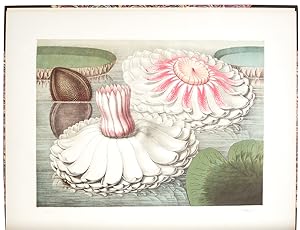
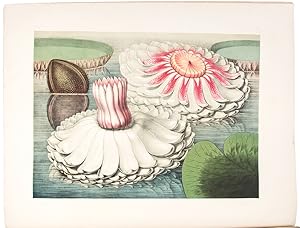
![Image du vendeur pour Buffalo Bill [and the "Frenchman's Bottle Gag," a comic tableau from the wild west show] mis en vente par Donald A. Heald Rare Books (ABAA)](https://pictures.abebooks.com/inventory/md/md765237727.jpg)
